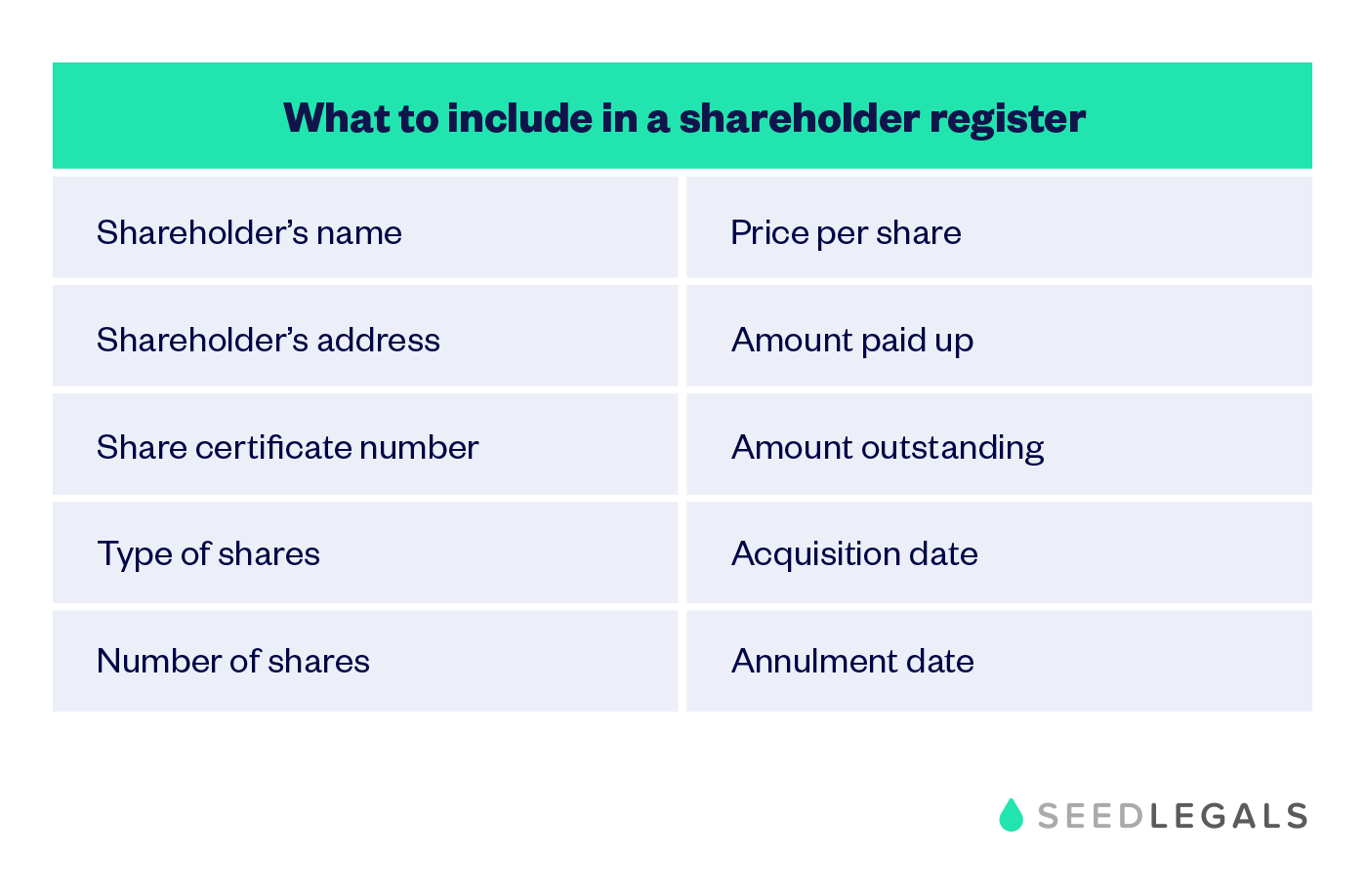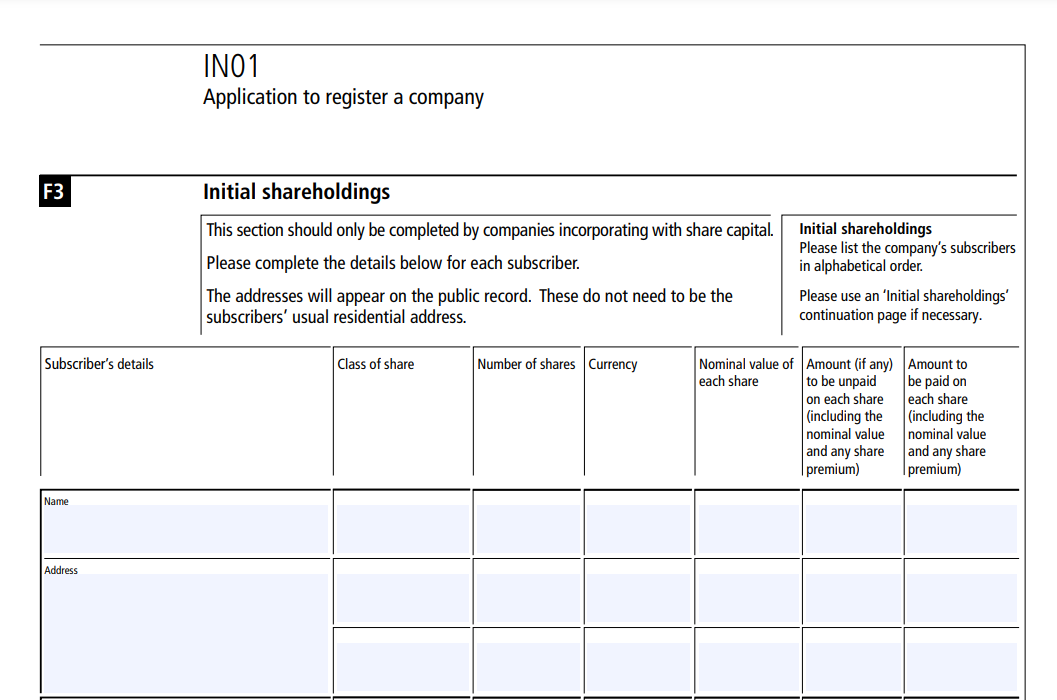Cap Table: What it is and why you need one
A capitalisation table shows who owns what in a company. We explain what a cap table is, why startups need one, and the...
The Companies Act 2006 refers to it as a register of members, but most people call this document a shareholder register. It’s a legally required document that all companies in the UK must keep. In this article, we’ll go into detail about what a shareholder register is and why you need one. We’ll also tell you how to create and manage your own.
A shareholder register (aka register of members) is a record of all the active and former owners of a company’s shares. A shareholder register includes the following details:

Yes. Every company needs a shareholder register because it’s a legally required document. It’s one of several statutory registers that a company must maintain, according to the Companies Act. The statutory registers named in the Companies Act are:
It’s the company’s responsibility to keep its own shareholder register. The directors (or the company secretary if the company has appointed one) are the ones who are legally responsible for maintaining it but the task is often delegated to a third party, for example, the company’s accountant.
The shareholder register must be kept up to date to ensure that all past and current shareholders are recorded. It shows the number of shareholders in each class of shares and acts as proof of ownership.
Anyone can ask to inspect your shareholder register and request copies of it at any time, so it must be kept available for inspection at your company’s registered office or a Single Alternative Inspection Location (SAIL). The register can be kept in hard copy or electronically but, if it’s kept electronically, it must be capable of being reproduced in hard copy form.
You can also opt to keep information from your register of members on the public register maintained by Companies House (known as the ‘central register’) instead of keeping your own register.
There is no prescribed format that you have to follow, so you’re free to choose how to present the information as long as you include all the required details.
Most shareholder registers are kept electronically and compiled in a simple table format, with one column dedicated to each category of information that is required to be included (name and address of the shareholder, class of shares, number of shares, nominal value, the price paid on the shares, etc).
The shareholder register can also be divided into share classes, under which the shareholders in that class are listed in alphabetical order, usually by last name. The register must always include details of their most recent address for contact purposes.
The shareholder register will detail the history of all shares issued to shareholders over the past decade, or sometimes even longer. Even if a shareholder sells all their shares and is no longer involved with the company, their details will remain on the register and they can only be removed after at least 10 years have passed since they ceased to be a shareholder.
The register will also provide information about the transfer of shares, including the name of the person they were transferred to. When someone buys shares, they only legally become a shareholder when their details have been entered into the register, so it’s important that you remember to update it as soon as possible.
✔ Issue and transfer shares
✔ Manage your cap table
✔ Create share certificates
Yes. When you first incorporate your company, you’ll give Companies House details of the company’s initial shareholdings. Below is a snapshot of the paper application to register a company (IN01):

After incorporation, you’ll have to tell Companies House if there are any changes to shareholder information. The shareholder information you’ll need to file at Companies House includes details such as:
You only have to do this once a year when you file the confirmation statement (CS01). If there is a share transfer or if the company issues new shares halfway through the confirmation period, you don’t have to file the updated shareholder information straight away and you can wait until your next confirmation statement is due.
If you have decided to keep shareholder information on the central register, you will need to notify Companies House of any changes to shareholders in real-time, rather than annually through the confirmation statement process.
According to the Companies Act 2006, anyone can ask to look at – and request a copy of – a company’s shareholder register.
It’s not just the company’s shareholders who have a right to inspect the register, members of the public can request to see it too.
If someone asks to view your shareholder register, they must give details on their purpose – why they want to view it – and how they will use the information. They must also confirm whether the information will be disclosed to any other person and, if so, confirm their identity and the purpose for which the information is to be used by that person.
You can either grant access or ask a court to decline the request if you believe the request was not made for a proper purpose. You must decide on how to proceed within five working days of the request.
There’s relatively little guidance on what courts would decide is ‘proper purpose’ and the assessment will be made on a case-by-case basis. In the case of a shareholder, the purpose should generally relate to the shareholders’ interest in that capacity and/or the exercise of their rights as a shareholder. For example, a shareholder could ask to inspect the register to assess whether a share transfer has been made without following the pre-emption process in the company’s articles of association. Legitimate requests from members of the public could involve, for example, investigations about corporate impropriety.
You can create and maintain a shareholder register yourself using any format you can easily print out (to comply with the Companies Act requirements). Your accountant may be able to do this for you.
You can also opt to keep information from your register of members on the public register maintained by Companies House (known as the ‘central register’) instead of keeping your own register. If you elect to keep information on the public register, you will need to notify Companies House of any changes to shareholders in real time, rather than annually when you file the confirmation statement.
All shareholders must give their consent before you can elect to keep information on the central register, as this will make the full address of each shareholder publicly available. Shareholders can choose to include a service address (rather than their usual residential address) on the public register to help protect their privacy.
Got more questions about your shareholder register, shareholders or cap table? We’re always happy to help. Hit the chat bubble to talk to one of our experts or book a free call with our team below.









